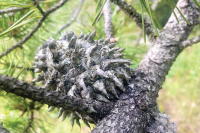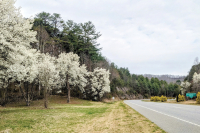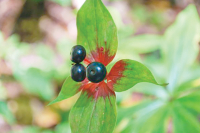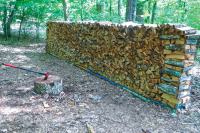Haywood wants a share of cycling tourists
 Since the first wheels starting turning in 2010’s inaugural Blue Ridge Breakaway bike ride, cycling has been picking up speed in Haywood County. And as more cyclists have flocked to the annual cruise of Haywood’s scenic byways, the county’s reputation as a cycling destination for the remaining 364 days of the year has grown as well. There might not be a lot of hard data on that yet, but the anecdotes flow freely.
Since the first wheels starting turning in 2010’s inaugural Blue Ridge Breakaway bike ride, cycling has been picking up speed in Haywood County. And as more cyclists have flocked to the annual cruise of Haywood’s scenic byways, the county’s reputation as a cycling destination for the remaining 364 days of the year has grown as well. There might not be a lot of hard data on that yet, but the anecdotes flow freely.
“Since we’ve begun hosting the Blue Ridge Breakaway, we’ve had two types of new visitors to Lake Junaluska outside of the Breakaway, and those are people that come for the day just to ride the Blue Ridge Breakaway routes, and we know for sure we get overnight stays from people that decide to stay here and ride the local rides,” said Ken Howle, development director for Lake Junaluska Conference and Retreat Center, also a cyclist and board member of the Haywood County Tourism Development Authority.
“I don’t have concrete numbers on what those are, but we’ve seen an increase in the number of vehicles with bicycle racks on them since we began hosting the Blue Ridge Breakaway five years ago,” said Howle.
Howle, along with an enthusiastic core of Haywood County cyclists and tourism officials, would like to see that increase continue, and they’re actively looking for ways to make it happen. Back in 2011, BicycleHaywoodNC — a bicycle club and advocacy group under the Blue Ridge Bicycle Club — cobbled together grants to fund a comprehensive bike plan for the county dealing with everything from infrastructure to education. This year saw completion of a new study, driven by BicycleHaywoodNC with funding from the Haywood County Tourism Development Authority and the Southwestern Commission, examining the economic impact an uptick of cycling tourism could cause in Haywood County — and a road map to capture it.
Called “Bikes in Beds,” — a play on words of the oft-cited goal of tourism professionals to get more “heads in (hotel) beds” — the report examines the changing dynamics of bicycle tourism and the specific opportunities Haywood is best poised to exploit. Cycling is a growing sport, the study says, with a tendency to generate longer trips and larger group sizes than average. Currently, bicycle-related tourism accounts for only about 2 percent of total trips to Western North Carolina, but that figure represents more than $14 million in travel expenditures annually and supports 140 jobs, the study says.
Related Items
Room to grow
There’s ample opportunity for that share to grow.
“There are many miles of rural roads throughout WNC that are popular among local cyclists, but less well known to those outside the region,” the study says, implying that if Haywood were to lay out the welcome mat and steer visitors toward the best bike routes, the county could grow quickly as a destination for multiple types of cyclists.
“I think a lot of people, especially if they’re not bicyclists or they’re not familiar, they think of those spandex-clad people or those sleek road bikes that are an element of bicycle tourism, but we did want to showcase in the study the different types of bicycle tourism,” said Don Kostelec, who is based in Asheville and was the lead author of the study (Kostelec rode more than 250 miles of Haywood roads while doing fieldwork for the study).
First of all, there are different kinds of bike sports — road biking, mountain biking, an emerging sport known as gravel biking that focuses on exploring unpaved back roads — and there are different kinds of people who partake in them. Those who stand to be enticed by bike tourism opportunities range from high-intensity athletes seeking a challenge on par with the Tour de France to families with young kids looking for a relaxing way to spend the afternoon.
Haywood has potential to serve all of those types of visitors. The county is home to plenty of scenic routes — for one, it has the highest-elevation Blue Ridge Parkway mileage of any county through which the Parkway passes — lots of public land suitable for mountain biking and miles of old Forest Service roads sufficient to keep gravel bikers busy for days.
Some of these tourism “products” are nearly complete. Others will take a little work to become competitive.
“Road biking enthusiasts, without a doubt, is the market that we can penetrate right now, and that’s because of the length of road we have on the Blue Ridge Parkway and the hundreds of miles of wonderful, rural, scenic paved roadways throughout Haywood County that have very low traffic and pass through wonderful communities,” said Howle.
So, while cycling tourism isn’t limited to, as Kostelec put it, “the spandex-clad,” at the moment that is the demographic Haywood is best suited to attract. Haywood is a mountainous county, with most of its low-traffic roads presenting bikers with challenging climbs and brisk descents. There aren’t any dedicated bike lanes, so cyclists who aren’t comfortable sharing the road with cars might be intimidated. And when it comes to families with kids, there are some low-stress places to go for a ride — Lake Junaluska and the Waynesville Recreation Park, for example — but none of those routes are yet long enough to provide a strong draw for out-of-towners.
Those realities provide a challenge to selling bike tourism in Haywood County. But they also provide an opportunity.
“A lot of people who are kind of those hardcore people that watch the Tour de France religiously and really are those spandex-clad folks, they want to find a place they can test their mettle against the terrain,” Kostelec said.
Haywood County provides plenty of opportunity, and with more than 1,000 cyclists preparing to pour into Waynesville for the kickoff of Cycle North Carolina’s Mountains to Coast ride this weekend, the TDA is looking to promote it. This week they’re getting in boxfuls of revised Haywood County biking guides, hot off the presses with five new bike routes added to the existing six. So far, the TDA’s awarded $11,300 toward projects to promote and develop bike tourism in the county and put $6,000 toward a downtown master plan for Maggie Valley, which includes a segment dedicated to developing bike tourism.
Later this season, they’re planning to host a community workshop aimed at educating people on bike tourism and the opportunities it presents.
A community effort
That workshop is more than a check-off to look good on paper. Buy-in from the hospitality industry and the community as a whole will be key to cycling’s success as a significant driver of tourism in Haywood County.
“Probably the biggest things cyclists notice are whether people are welcoming or not,” said George Ivey, a BicycleHaywoodNC member who lives in Bethel. “It’s great to have the signs and the maps and everything else, but if people honk at you unnecessarily or pass you and take a right turn and nearly make you crash into their car, those are the things that really deter a cyclist.”
Luckily, hospitality is something Haywood is known for.
“I think the friendly attitude overall of people in Haywood County is certainly a big bonus,” said BicycleHaywoodNC member Cecil Yount.
But more specifically, a community that hangs its hat on bike tourism should be aware of the amenities cyclists need and the lingo they use. Cyclists, for example, will want to either take their bikes into their hotel rooms or lock them in some kind of secure, outdoor storage. They’ll need a place to wash their bikes and old rags to wipe them down with, sparing the hotel’s clean linens. Having simple tools like a bike pump or multi-tool on hand at the front desk can go a long way. And adding well-known bike routes and destinations to the hotel’s list of area attractions to share with tourists sends a message that bike tourists are welcome and accepted.
If a cyclist sitting in a restaurant tells the waitress they’re there to ride the roads, Kostelec said, “We don’t want their response to be, ‘Oh my god, you’ll get yourself killed.’ We want them to respond, ‘Well, it’s beautiful out there. We have some beautiful roads, and be careful.”
“I think it’s really going to take a community effort,” agreed BicycleHaywood NC member Jennifer Jacobson.
Safety is often a stumbling block for those considering exploring Haywood’s roads on a bicycle, Yount said, but according to the study Haywood’s accident rate is much lower than that of similar counties. In a comparison of crash rates per 100,000 people for North Carolina counties between 50,000 and 70,000 in population, Haywood County came in last. Of course, it’s hard to pinpoint why, as the statistic doesn’t take into account other data, such as the volume of cyclists in each county. And it’s undeniable that a crash on a bicycle is more likely to end in serious injury than a crash in a car. Still, the study says, “Data suggests bicycling in Haywood County is safe for those who are comfortable riding along roads without shoulders or bicycle lanes.”
An eye on infrastructure
In the longterm, everyone involved agrees, it would be great to get some more infrastructure in place to handle and encourage bicycle traffic. Bike lanes, wider shoulders and dedicated bicycle paths would be wonderful, but those are expensive, difficult projects. Especially in the mountains, where topography often makes road widening next to impossible.
In the 2011 Haywood County Comprehensive Bicycle Plan, also prepared by Kostelec, several recommended infrastructure projects are listed, nearly all priced in the millions of dollars. Roadwork never comes cheap, and it rarely comes quickly, as projects on state-maintained roads have to wait their turn to rise to the top of the N.C. Department of Transportation’s priority rankings.
“As highway projects are planned, it’s going to be important for Haywood County to work with the Department of Transportation around appropriate improvements that would aid in our efforts to encourage cyclists to come to Haywood County,” Howle said. “Those are long-term projects that have to begin now, so that long-term we can see the impact.”
In the here and now, however, cycling and tourism groups can work on maps, marketing, amenities — the lower-hanging fruit. The town of Waynesville, for example, has already made some progress there, painting “sharrows” — icons on the road reminding motorists to share the road with bikers — and installing 30 green bike racks all over town.
Developing opportunity
But what about cyclists who don’t fall into the category of intense road biker? The mountain bikers, the casual pedelers?
The consensus seems to be that mountain biking might be the next market to go after, with a long greenway for families the more challenging goal to tackle.
“I would say mountain biking is the next thing they could capture,” Kostelec said.
Right now, Haywood’s a gap between destinations as far as mountain biking is concerned. Buncombe and Transylvania counties have significant trail systems — Bent Creek, Mills River, DuPont State Forest — and further west there’s Tsali Recreation Area near Bryson City and the Western Carolina University trail system in Jackson County.
“There’s only a small number of mountain biking trails in Haywood County,” Jacobson said. “However, Haywood County is a good central hub to access other more developed mountain biking trails.”
So, while Haywood could stand to get some trails of its own — Kostelec’s suggestion is to develop the Rough Creek Watershed trails in Canton for that purpose — there’s some thought that Haywood could start selling itself as a central jump-off point for mountain bikers wanting to have their pick of trail systems in easy driving range.
The Holy Grail of bike tourism, however, would be a long greenway — meaning 10 or more miles — giving novice riders and families with young children the separation from traffic they need to feel safe.
Such discussions often rope in the Virginia Creeper Trail in southwest Virginia, a 33-mile graveled path along the line of the former Virginia-Carolina Railroad company that’s proven especially revolutionary for Damascus, a little town that’s gone from dying logging community to outdoors hub due largely to its junctions with both the Creeper and Appalachian trails. There’s also the Swamp Rabbit Trail near Travelers Rest, South Carolina, whose mayor has declared publicly that the trail has done wonders for the small town.
But while such corridors may spell success for the towns they traverse, they’re difficult to create. Gaining easement agreements through private property is challenging at best and expensive to fund. Achieving a trail of any length requires navigating the varied regulations of the entities through which the route passes.
“A lot of times when trails like that come together, it’s a perfect storm of circumstances that allow for that,” said Sarah Thompson, planning director for the Southwestern Commission, which offered up a chunk of the grant money to complete the Haywood bike studies. Thompson also worked on a 2013 DOT-funded regional bike plan for Haywood, Swain, Jackson, Transylvania, Buncombe, Madison and Henderson counties, and the Southwestern Commission is just gearing up to start a similar endeavor for the four remaining western counties — Macon, Graham, Clay and Cherokee.
Haywood County already has some pieces of greenway — a mile or so through the Waynesville Recreation Park, a piece over near Lake Junaluska, smatterings in Maggie Valley, Clyde and Canton — and the dream is to someday link them together into one, long trail. That might happen someday, but it will take years, and likely decades, to come to fruition.
“That’s something we really need to work on, because the greenway gives us the best possibility for developing a bicycle route that not only tourists would enjoy but would create a more vibrant Haywood County community,” Howle said.
A regional opportunity
A greenway isn’t Haywood’s only chance to link communities via bicycle. To the contrary, as time goes on it’s possible that not just Haywood but all of Western North Carolina could work together to sell itself as the place to be if you like two wheels.
“I think in the future it would be helpful to take things to a more regional level and incorporate other options,” Ivey said.
A dedicated cyclist who’s ridden across the state with Cycle North Carolina and pedaled the entire 469-mile Blue Ridge Parkway and 444-mile Natchez Trace Parkway, Ivey’s into the long-distance stuff. One aspect of Cycle N.C. that he loved was the fact that the organizers shuttled the bikers’ gear from one town to the next. He got to travel light.
What if someone with an entrepreneurial spirit made the same thing possible in WNC?
“I think it would be fun to figure out how to work with places like Sylva and Franklin and Cherokee and figure out some different trips,” Ivey said. “People could do a whole four-day circuit.”
If a community showed itself to be behind the idea of taking on the bike town identity, a host of entrepreneurial opportunities could appear. For instance, said the TDA’s communications manager Anna Smathers, the TDA gets all kinds of calls from people who want to know where they can rent bikes. Right now, there’s nowhere in Haywood to send them. A shuttle business, Kostelec added, would be ideal for promoting Waynesville’s proximity to the Parkway.
“The Blue Ridge Parkway is a big draw for people that are making multi-day bicycle trips,” he said, “and riding down into Waynesville is an easy thing because it’s mostly downhill, but those people may not be inclined to start the next day with a 20-mile climb.”
A pick-your-poison outdoor destination
There’s existing traffic, potential for growth and need for buy-in. But nobody’s saying that cycling is or should be Haywood’s sole identity. Rather, the county’s strength — like that of many of the western counties — is in the strong portfolio of outdoor options it offers.
“It’s important for Haywood County to have a diverse tourism community, meaning that we have a variety of things that we can offer people based on what their interests are, and cycle tourism is a key part of that,” Howle said.
The appeal of cycling benefits from the presence of the other amenities — the hiking, the fishing, the small towns full of festivals and nice restaurants for visiting families.
“I think the added value a place like Haywood County has is maybe I ride and love those things but my spouse does not,” Kostelec said. “Well, this is certainly an attractive enough place that bringing the rest of the family, even if you spent a day or two riding, there’s plenty else for them to do.”
With the Blue Ridge Breakaway going strong and a whole new set of cyclists poised to find out what Haywood County has to offer when the Mountains to Coast ride starts Sunday (Sept. 27), the wheels of cycling tourism are beginning to turn. Tourism and cycling groups are hoping they catch momentum.
“Everyone benefits from any increase in tourism, because tourists spend money and contribute to the local economy,” Howle said. “Every business — no matter who it is — would benefit from increased visits from cyclists in Haywood County.”
Haywood’s not the only county in WNC to have the raw materials to reel in the biking crowd. But for now, it’s the one most aggressively going after the market.
“Bicycling is one of those things that’s rising rapidly, and they’re ready to catch that wave like they always are,” Kostelec said of Haywood.
According to the Outdoor Industry Association’s 2014 report, bikers’ numbers aren’t exploding, but they are growing, with mountain bike participation increasing by 6.4 percent and road biking by 1.4 percent.
“We’re very excited about the future of bicycle tourism for the county,” Smathers said. “It definitely shows it’s a tourism market that works for us and is popular for us, so I know we’re looking forward to seeing where it takes us in the future.”
Read it yourself
The Bikes in Beds study examining the economic potential of bike tourism in Haywood County is available online at www.bicyclehaywoodnc.org/news.html.
By the numbers
- $14 million estimated total impact of bicycle tourism in Western North Carolina
- $150,000 to $170,000 estimated visitor spending per year from the Blue Ridge Breakaway
- $500,000 estimated economic impact of the 2014 Lake Logan Multisport Festival.
- 91.5 million Americans went biking in 2013
- 33 percent of cycling tourists staying overnight
- $76 spent per day of overnight stay and $50 per day trip
- 2.8 people in the average group of cyclists
Source: Bikes in Beds: How to maximize bicycle tourism in Haywood County and WNC













